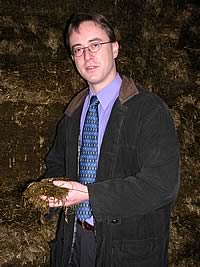 |
|||||||||
|
|||||||||||||||||||
| Yeast
Culture Aids Performance in
Dairy Cows 23/11/05
Increased milk yields and improved feed conversion efficiency were the key responses in high yielding dairy cows that were fed a live yeast culture supplement in trials carried out at Harper Adams University College earlier this year. The 12-week study involving two groups of 20 Holstein Friesian cows showed that Alltech's Yea-Sacc1026 Farm Pak fed in the total mixed ration at 50g/head/day produced a significant (12%) increase in feed efficiency during the first four weeks of inclusion and an average milk yield response of 1 litre (2.5%) over the entire period. Feed conversion efficiency was comparable or better throughout the period in the cows receiving the yeast culture, and milk yield was significantly higher in the treated cows by week five of the trial, rising to its biggest differential (3.4%) in the final four week segment. Commenting on the results, Alltech UK's ruminant technical manager David Wilde emphasised the importance of the feed efficiency response - as much as the additional milk yield - to dairy unit profitability. "Greater efficiency has to be a key goal for dairy farmers going forward, so in this sense the ability of a product like Yea-Sacc to improve the way the cow uses other components of the diet is very relevant indeed in the current climate," he said. "Feed conversion efficiency (FCE) in this context is calculated as kilograms of milk produced per kilograms of feed dry matter consumed. It is not a measurement that is commonly used by dairy farmers, largely because issues like variable forage quality and changes in animal live weight tend to cloud the picture in the on-farm situation, but in this trial we can see that it is a relevant indication of improved performance. "Forage quality was high, and identical, for both groups, and the live weight change was measured over the period. The cows receiving Yea-Sacc actually gained more weight than their counterparts, as well as producing more milk, so if anything this shows feed efficiency was even greater in the treated group than it appears in the basic FCE calculation." The milk yield response increased throughout the 12-week period, reaching its highest level at the end of the recording period. According to David Wilde, this is the normal pattern of events and is due to the way that the live yeast culture works in the rumen. "Yea-Sacc works by stimulating the activity of beneficial rumen bacteria and stabilising the rumen environment," he explained. "This produces improvements in fibre digestion, resulting in production benefits in terms of milk yield and growth rates. "This is a biological process, so typically takes 3-4 weeks before a notable response is seen in the animals. This was confirmed in the Harper Adams trials, where the effect of Yea-Sacc increased throughout the 12 weeks. We would expect this to stablise and then be sustained for as long as the supplement is fed." Cows in the trial were on average about 10 weeks into lactation and producing 38.1 kg/day of milk at the outset.
|
|||||||||||||||||||

|
|
||||||||||||||||||
| home | agri-services | pedigree
pen | news | dairy | beef | machinery BPS | property | organisations | site map |
|||||||||||||||||||
